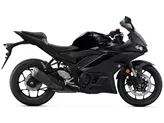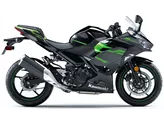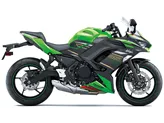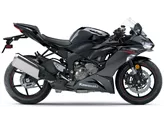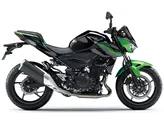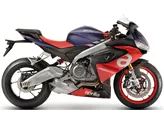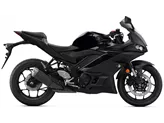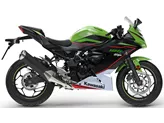Kawasaki Ninja ZX-6R 2019 vs. Kawasaki Ninja 400 2018

Kawasaki Ninja ZX-6R 2019

Kawasaki Ninja 400 2018
Vue d’ensemble - Kawasaki Ninja ZX-6R 2019 vs Kawasaki Ninja 400 2018
In terms of engine and drive train, the Kawasaki Ninja ZX-6R 2019 has a more powerful engine with 130 HP compared to the Ninja 400 2018's 45 HP. The ZX-6R also has a higher torque of 70.8 Nm compared to the Ninja 400's 38 Nm. The ZX-6R has a larger displacement of 636 ccm compared to the Ninja 400's 399 ccm. Both bikes have an in-line engine type with 4 cylinders and 4 valves per cylinder.
In terms of suspension, the ZX-6R has an upside-down telescopic fork front suspension with a diameter of 41 mm, while the Ninja 400 has a telescopic fork front suspension with the same diameter. Both bikes have a swing arm rear suspension with a monoshock, but the ZX-6R has the added feature of adjustment for compression, preload, and rebound.
In terms of chassis, the ZX-6R has an aluminum frame type called Twin Tube, Perimeter, Extruded, while the Ninja 400 has a steel frame type called Tubular. The ZX-6R has a slightly steeper rake of 66.5 degrees compared to the Ninja 400's 63 degrees. The ZX-6R also has a longer trail of 101 mm compared to the Ninja 400's 93 mm.

Kawasaki Ninja ZX-6R 2019
In terms of brakes, the ZX-6R has double disk front brakes with a diameter of 310 mm and radial technology, while the Ninja 400 has a single disk front brake with the same diameter and petal technology.
Both bikes have ABS as an advanced rider assistance system, but the ZX-6R also has additional features such as riding modes, ride by wire, and traction control.
In terms of dimensions and weights, the ZX-6R has a wider front tire width of 120 mm compared to the Ninja 400's 110 mm. Both bikes have the same front tire diameter of 17 inches. The ZX-6R has a wider rear tire width of 180 mm compared to the Ninja 400's 150 mm, and both have the same rear tire diameter of 17 inches. The ZX-6R has a longer wheelbase of 1400 mm compared to the Ninja 400's 1370 mm. The ZX-6R also has a higher seat height of 830 mm compared to the Ninja 400's 785 mm. Both bikes have a fuel tank capacity of 14 liters.

Kawasaki Ninja 400 2018
In terms of strengths, the ZX-6R has a great engine with a good balance of revving and torque, providing a thrilling supersport experience without sacrificing comfort. It also has a responsive fork and adjustable chassis for optimal handling. On the other hand, the Ninja 400 has a chassis that is suitable for sporty use, with a low weight and effortless handling. Its engine has smooth response, and it offers a relaxed and confidence-enhancing seating position. Additionally, it features LED headlights.
In terms of weaknesses, the ZX-6R could use more finesse in certain details such as the number plate holder and indicators. Its overall silhouette could also be more sporty and aggressive. The Ninja 400, on the other hand, has non-adjustable brake and clutch levers and can produce loud wind noise for taller riders with the original windshield.
Overall, the Kawasaki Ninja ZX-6R 2019 is a more powerful and advanced supersport motorcycle with adjustable features and a sporty design. The Kawasaki Ninja 400 2018, on the other hand, is a lightweight and agile option with a comfortable seating position and smooth engine response.
Caractéristiques techniques Kawasaki Ninja ZX-6R 2019 par rapport à Kawasaki Ninja 400 2018
Avantages et inconvénients en comparaison
Avantages et inconvénients en comparaison
Kawasaki Ninja ZX-6R 2019

La Kawasaki Ninja ZX-6R est une moto supersport bien dimensionnée. Avec ses 130 ch, elle permet une conduite sportive mais contrôlée. Le rapport de transmission plus court et la cylindrée supplémentaire de 36 cm3 permettent de rouler un peu plus feignant pour débrayer. Un digne virage pour le segment des supersports de 600 cm3.
Kawasaki Ninja 400 2018

En résumé, la Ninja 400 pourrait être considérée comme l'entrée parfaite dans le monde des supersports. Il n'est pas possible d'avoir plus de puissance avec un A2, l'apparence laisse présager beaucoup plus de puissance, le véhicule est ludique à conduire, il est tolérant à tous points de vue et permet malgré tout une conduite vraiment sportive. Ceux qui avaient encore des doutes parfois justifiés sur le manque de puissance des diverses machines de 250 cc n'ont plus d'excuses. Ninja 400, c'est bien que tu sois là !
Comparaison des prix Prix moyen du marché Kawasaki Ninja ZX-6R vs Kawasaki Ninja 400
There are a few key differences between a Kawasaki Ninja ZX-6R 2019 and a Kawasaki Ninja 400 2018. In terms of price, the actual average price of a Kawasaki Ninja ZX-6R 2019 is about 163% higher. Compared to Kawasaki Ninja 400 2018 there are less Kawasaki Ninja ZX-6R 2019 bikes available on the 1000PS.de Marketplace, specifically 4 compared to 10. It takes less time to sell a Kawasaki Ninja 400 with 105 days compared to 160 days for the Kawasaki Ninja ZX-6R. Since model year 2005 1000PS.de editors have written 37 reviews for the Kawasaki Ninja ZX-6R and 9 reviews for the Kawasaki Ninja 400 since model year 2018. The first review for the Kawasaki Ninja ZX-6R was published on 9/2/2002 and now has more than 5,800 views. This compares to more than 44,300 views for the first review on Kawasaki Ninja 400 published on 11/22/2017.


